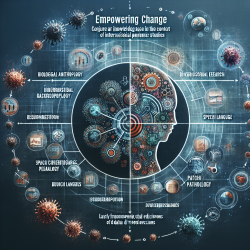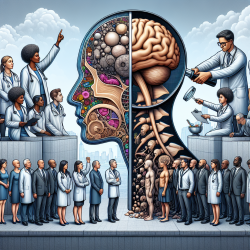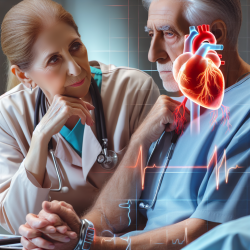Unlocking Potential: How Chemoinformatics Can Transform Speech-Language Pathology

Introduction
In the realm of speech-language pathology, particularly when working with children, the integration of cutting-edge technology and data-driven approaches can significantly enhance therapeutic outcomes. One such promising field is chemoinformatics, which, although traditionally associated with chemistry and pharmacology, offers valuable insights that can be leveraged in speech-language pathology. This blog explores how findings from the 11th German Conference on Chemoinformatics (GCC 2015) can inspire practitioners to improve their skills and outcomes for children through innovative research and technology.
Understanding Chemoinformatics
Chemoinformatics involves the use of computational techniques to solve chemical problems, particularly in drug discovery and material sciences. It combines elements of chemistry, computer science, and information technology to manage and analyze chemical data. The field has evolved to include applications in biology and medicine, making it relevant for speech-language pathologists who are interested in data-driven decision-making.
Key Insights from GCC 2015
The 11th German Conference on Chemoinformatics highlighted several advancements that can be translated into the field of speech-language pathology:
- Data Integration: Chemoinformatics emphasizes the integration of large volumes of heterogeneous data. Speech-language pathologists can adopt similar approaches to integrate diverse data sources, such as patient records, therapy outcomes, and linguistic databases, to inform treatment plans.
- Predictive Modeling: The conference showcased the use of predictive modeling to anticipate outcomes and optimize interventions. In speech-language pathology, predictive models can be developed to forecast therapy success, tailor interventions, and monitor progress over time.
- Virtual Screening: Virtual screening techniques used in chemoinformatics can be adapted to identify effective therapeutic strategies or tools for speech-language interventions, ensuring that resources are used efficiently and effectively.
Implementing Chemoinformatics in Speech-Language Pathology
To harness the potential of chemoinformatics, speech-language pathologists can consider the following steps:
- Embrace Data-Driven Practices: Utilize software and tools that allow for the collection and analysis of data from various sources. This can lead to more personalized and effective therapy plans for children.
- Collaborate with Researchers: Engage with chemoinformatics researchers to explore how their methodologies can be adapted to speech-language pathology. This interdisciplinary collaboration can lead to innovative solutions and improved child outcomes.
- Invest in Training: Encourage continuous professional development in data analytics and computational methods. This investment will empower practitioners to make informed decisions based on robust data analysis.
Encouraging Further Research
The intersection of chemoinformatics and speech-language pathology is a relatively unexplored area with significant potential. Practitioners are encouraged to pursue further research to explore how chemoinformatics can enhance therapeutic interventions and outcomes for children. By participating in conferences, collaborating with interdisciplinary teams, and publishing findings, speech-language pathologists can contribute to the advancement of the field.
To read the original research paper, please follow this link: 11th German Conference on Chemoinformatics (GCC 2015).
Citation: Fechner, U., de Graaf, C., Torda, A. E., Güssregen, S., Evers, A., Matter, H., Hessler, G., Richmond, N. J., Schmidtke, P., Segler, M. H. S., Waller, M. P., Pleik, S., Shea, J.-E., Levine, Z., Mullen, R., van den Broek, K., Epple, M., Kuhn, H., Truszkowski, A., Zielesny, A., Fraaije, J., Gracia, R. S., Kast, S. M., Bulusu, K. C., Bender, A., Yosipof, A., Nahum, O., Senderowitz, H., Krotzky, T., Schulz, R., Wolber, G., Bietz, S., Rarey, M., Zimmermann, M. O., Lange, A., Ruff, M., Heidrich, J., Onlia, I., Exner, T. E., Boeckler, F. M., Bermudez, M., Firaha, D. S., Hollóczki, O., Kirchner, B., Tautermann, C. S., Volkamer, A., Eid, S., Turk, S., Rippmann, F., Fulle, S., Saleh, N., Saladino, G., Gervasio, F. L., Haensele, E., Banting, L., Whitley, D. C., Oliveira Santos, J. S., Bureau, R., Clark, T., Sandmann, A., Lanig, H., Kibies, P., Heil, J., Hoffgaard, F., Frach, R., Engel, J., Smith, S., Basu, D., Rauh, D., Boeckler, F. M., Essex, J. W., Bodnarchuk, M. S., Ross, G. A., Finkelmann, A. R., Göller, A. H., Schneider, G., Husch, T., Schütter, C., Balducci, A., Korth, M., Ntie-Kang, F., Günther, S., Sippl, W., Mbaze, L. M., Simoben, C. V., Lifongo, L. L., Judson, P., Barilla, J., Lokajíček, M. V., Pisaková, H., Simr, P., Kireeva, N., Petrov, A., Ostroumov, D., Solov'ev, V. P., Pervov, V. S., Friedrich, N.-O., Sommer, K., Rarey, M., Kirchmair, J., Proschak, E., Weber, J., Moser, D., Kalinowski, L., Achenbach, J., Mackey, M., Cheeseright, T., Renner, G., Schmidt, T. C., Schram, J., Egelkraut-Holtus, M., van Oeyen, A., Kalliokoski, T., Fourches, D., Ibezim, A., Mbah, C. J., Adikwu, U. M., Nwodo, N. J., Steudle, A., Masek, B. B., Nagy, S., Baker, D., Soltanshahi, F., Dorfman, R., Dubrucq, K., Patel, H., Koch, O., Mrugalla, F., Ain, Q. U., Fuchs, J. E., Owen, R. M., Omoto, K., Torella, R., Pryde, D. C., Glen, R., Hošek, P., Spiwok, V., Mervin, L. H., Barrett, I., Firth, M., Murray, D. C., McWilliams, L., Cao, Q., Engkvist, O., Warszycki, D., Śmieja, M., Bojarski, A. J., Aniceto, N., Bender, A., Freitas, A., Ghafourian, T., Herrmann, G., Eigner-Pitto, V., Naß, A., Wolber, G., Kurczab, R., Lange, A., Günther, M. B., Zimmermann, M. O., Hennig, S., Büttner, F. M., Schall, C., Sievers-Engler, A., Ansideri, F., Koch, P., Stehle, T., Laufer, S., Zdrazil, B., Montanari, F., Ecker, G. F., Grebner, C., Hogner, A., Ulander, J., Edman, K., Guallar, V., Ulander, J., Tyrchan, C., Klute, W., Bergström, F., Kramer, C., Nguyen, Q. D., Sippl, W., Frach, R., Kibies, P., Strohfeldt, S., Böttcher, S., Pongratz, T., Horinek, D., Rupp, B., Al-Yamori, R., Lisurek, M., Kühne, R., Furtado, F., van den Broek, K., Wessjohann, L., Mathea, M., Baumann, K., Mohamad-Zobir, S. Z., Fu, X., Fan, T.-P., Bender, A., Kuhn, M. A., Sotriffer, C. A., Zoufir, A., Li, X., Mervin, L., Berg, E., Polokoff, M., Ihlenfeldt, W. D., Pretzel, J., Alhalabi, Z., Fraczkiewicz, R., Waldman, M., Clark, R. D., Shaikh, N., Garg, P., Kos, A., Himmler, H.-J., Sandmann, A., Jardin, C., Sticht, H., Steinbrecher, T. B., Dahlgren, M., Cappel, D., Lin, T., Wang, L., Krilov, G., Abel, R., Friesner, R., Sherman, W., Pöhner, I. A., Panecka, J., Wade, R. C., Bietz, S., Schomburg, K. T., Hilbig, M., Rarey, M., Jäger, C., Wieczorek, V., Westerhoff, L. M., Borbulevych, O. Y., Demuth, H.-U., Buchholz, M., Schmidt, D., Rickmeyer, T., Krotzky, T., Kolb, P., Mittal, S., Sánchez-García, E., Nogueira, M. S., Oliveira, T. B., da Costa, F. B., Schmidt, T. J. (2016). 11th German Conference on Chemoinformatics (GCC 2015). Journal of Cheminformatics, 8(Suppl 1), I1. https://doi.org/10.1186/s13321-016-0119-5










